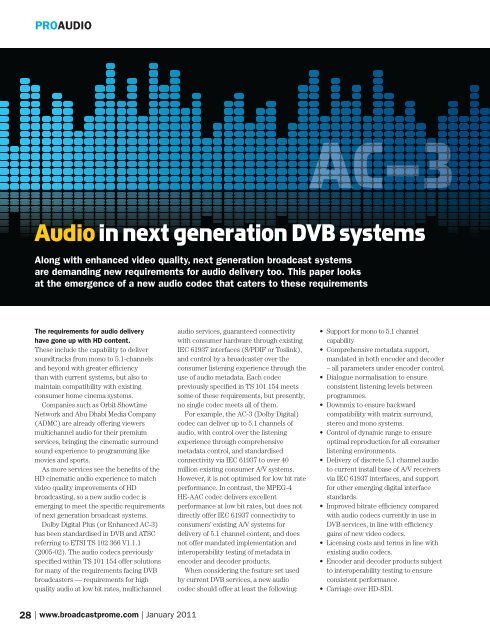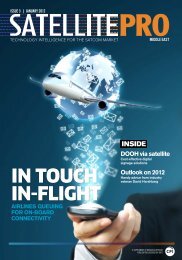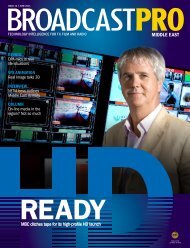cabsat - Broadcastpro Middle East
cabsat - Broadcastpro Middle East
cabsat - Broadcastpro Middle East
Create successful ePaper yourself
Turn your PDF publications into a flip-book with our unique Google optimized e-Paper software.
PROAUDIO<br />
Audio in next generation DVB systems<br />
Along with enhanced video quality, next generation broadcast systems<br />
are demanding new requirements for audio delivery too. This paper looks<br />
at the emergence of a new audio codec that caters to these requirements<br />
The requirements for audio delivery<br />
have gone up with HD content.<br />
These include the capability to deliver<br />
soundtracks from mono to 5.1-channels<br />
and beyond with greater ef� ciency<br />
than with current systems, but also to<br />
maintain compatibility with existing<br />
consumer home cinema systems.<br />
Companies such as Orbit Showtime<br />
Network and Abu Dhabi Media Company<br />
(ADMC) are already offering viewers<br />
multichannel audio for their premium<br />
services, bringing the cinematic surround<br />
sound experience to programming like<br />
movies and sports.<br />
As more services see the bene� ts of the<br />
HD cinematic audio experience to match<br />
video quality improvements of HD<br />
broadcasting, so a new audio codec is<br />
emerging to meet the speci� c requirements<br />
of next generation broadcast systems.<br />
Dolby Digital Plus (or Enhanced AC-3)<br />
has been standardised in DVB and ATSC<br />
referring to ETSI TS 102 366 V1.1.1<br />
(2005-02). The audio codecs previously<br />
speci� ed within TS 101 154 offer solutions<br />
for many of the requirements facing DVB<br />
broadcasters — requirements for high<br />
quality audio at low bit rates, multichannel<br />
28<br />
| www.broadcastprome.com | January 2011<br />
audio services, guaranteed connectivity<br />
with consumer hardware through existing<br />
IEC 61937 interfaces (S/PDIF or Toslink),<br />
and control by a broadcaster over the<br />
consumer listening experience through the<br />
use of audio metadata. Each codec<br />
previously speci� ed in TS 101 154 meets<br />
some of these requirements, but presently,<br />
no single codec meets all of them.<br />
For example, the AC-3 (Dolby Digital)<br />
codec can deliver up to 5.1 channels of<br />
audio, with control over the listening<br />
experience through comprehensive<br />
metadata control, and standardised<br />
connectivity via IEC 61937 to over 40<br />
million existing consumer A/V systems.<br />
However, it is not optimised for low bit rate<br />
performance. In contrast, the MPEG-4<br />
HE-AAC codec delivers excellent<br />
performance at low bit rates, but does not<br />
directly offer IEC 61937 connectivity to<br />
consumers’ existing A/V systems for<br />
delivery of 5.1 channel content, and does<br />
not offer mandated implementation and<br />
interoperability testing of metadata in<br />
encoder and decoder products.<br />
When considering the feature set used<br />
by current DVB services, a new audio<br />
codec should offer at least the following:<br />
AC-3<br />
• Support for mono to 5.1 channel<br />
capability<br />
• Comprehensive metadata support,<br />
mandated in both encoder and decoder<br />
– all parameters under encoder control.<br />
• Dialogue normalisation to ensure<br />
consistent listening levels between<br />
programmes.<br />
• Downmix to ensure backward<br />
compatibility with matrix surround,<br />
stereo and mono systems.<br />
• Control of dynamic range to ensure<br />
optimal reproduction for all consumer<br />
listening environments.<br />
• Delivery of discrete 5.1 channel audio<br />
to current install base of A/V receivers<br />
via IEC 61937 interfaces, and support<br />
for other emerging digital interface<br />
standards.<br />
• Improved bitrate effi ciency compared<br />
with audio codecs currently in use in<br />
DVB services, in line with ef� ciency<br />
gains of new video codecs.<br />
• Licensing costs and terms in line with<br />
existing audio codecs.<br />
• Encoder and decoder products subject<br />
to interoperability testing to ensure<br />
consistent performance.<br />
• Carriage over HD-SDI.






